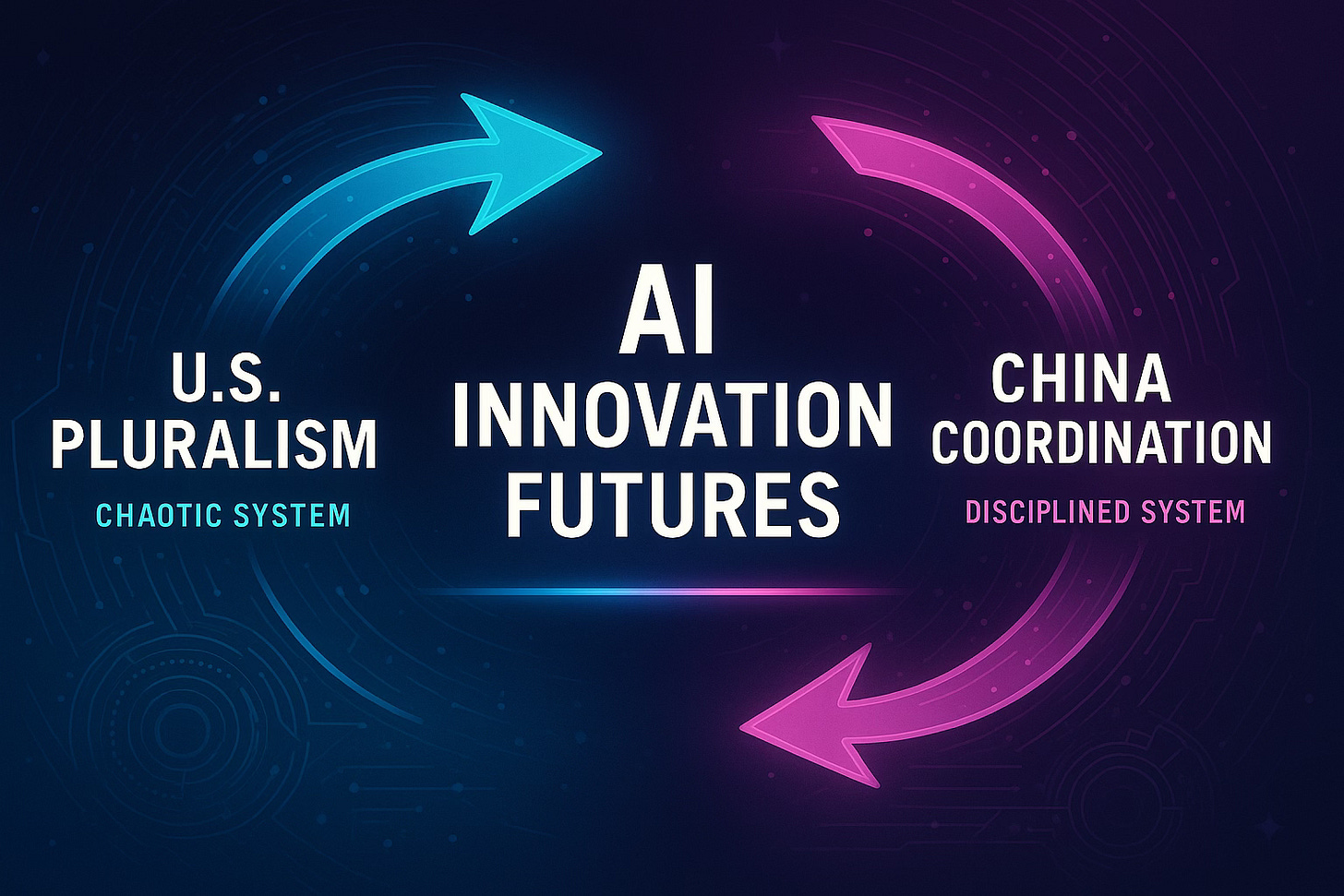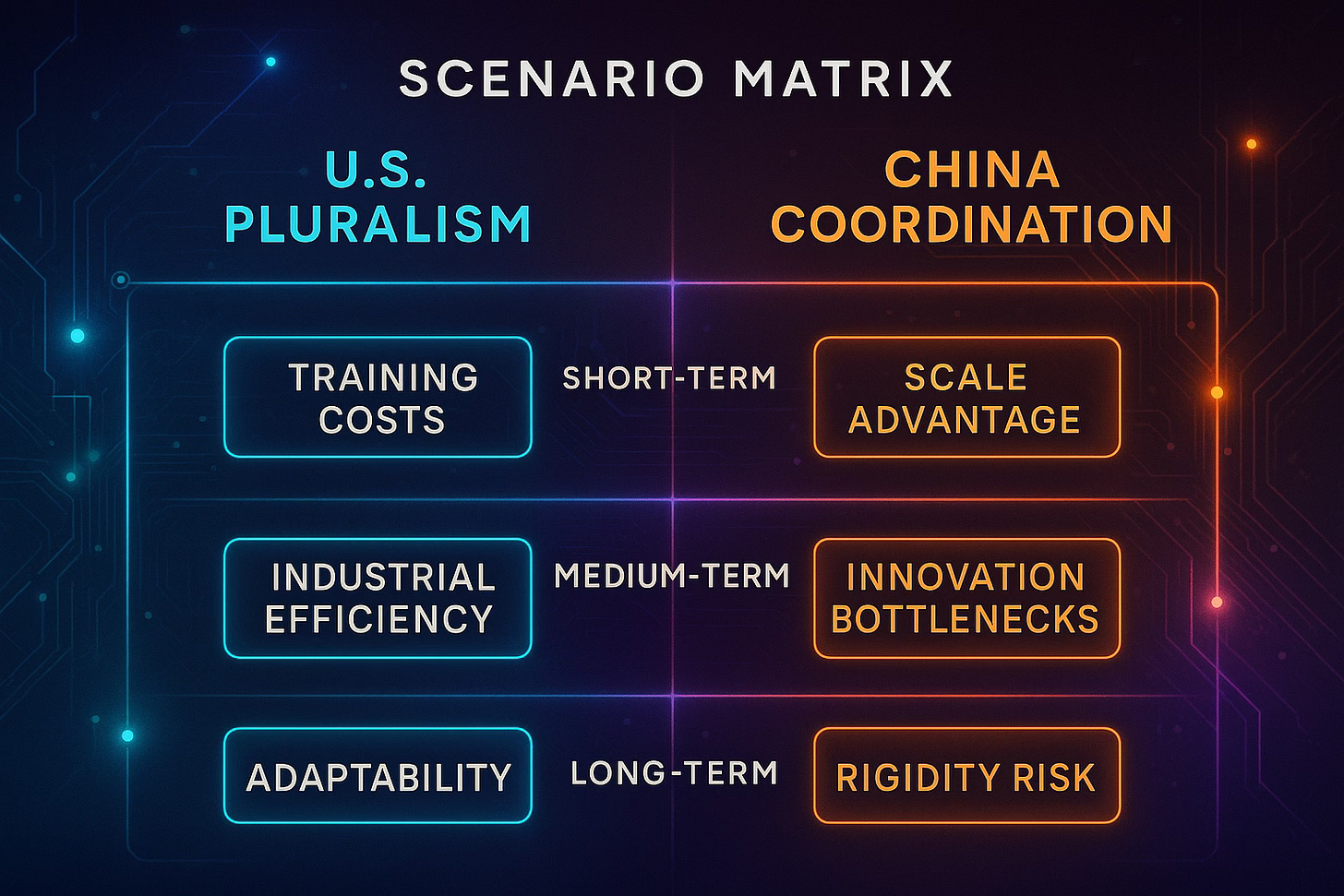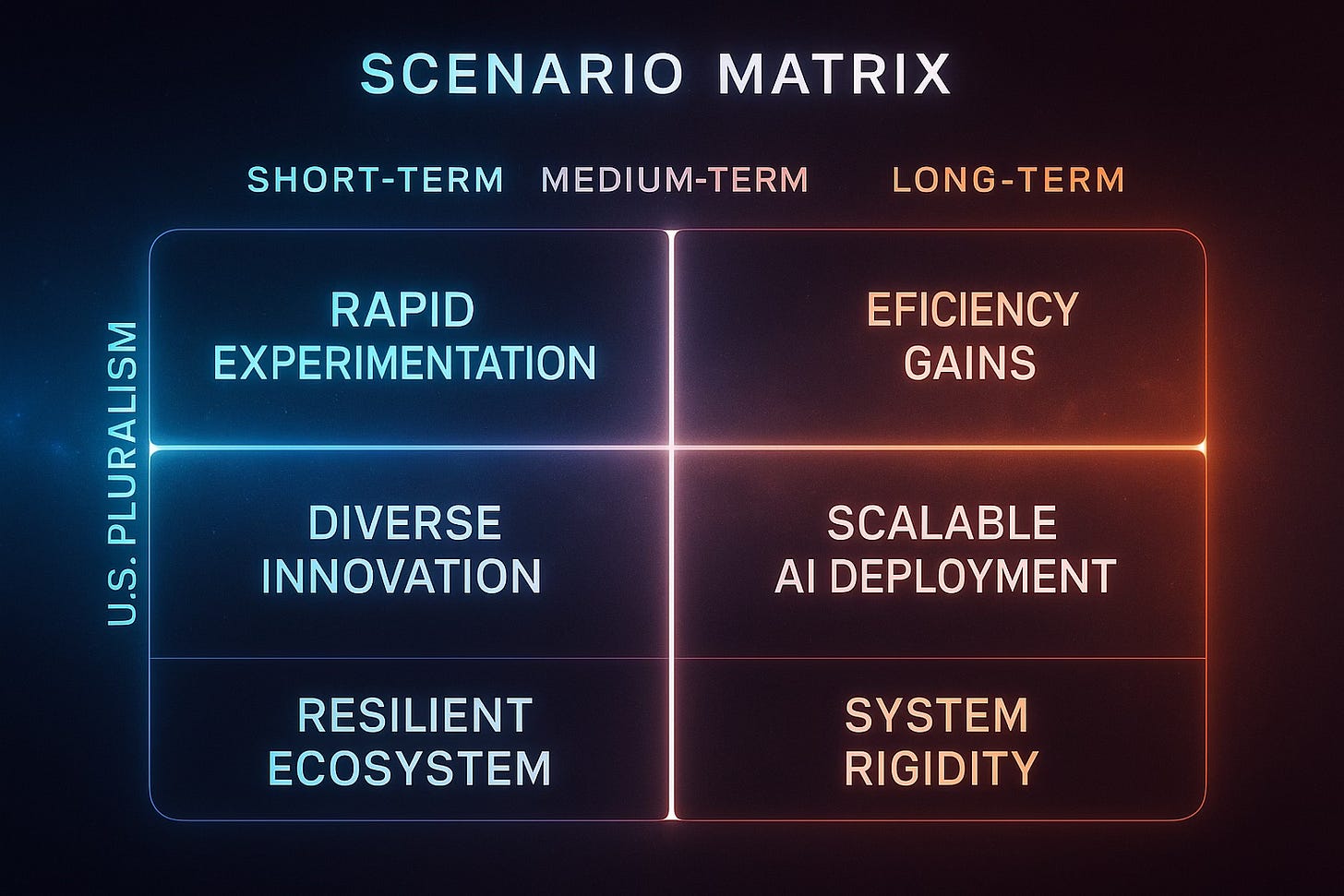MCAI National Innovation Vision: The AI Duel of America's Chaotic Advantage vs. China's Disciplined Coordination
A Vision for Innovation in the Age of AI, Commentary on Bloomberg
MindCast AI is built to turn complexity into foresight. By modeling nations, companies, and infrastructures as Cognitive Digital Twins (CDTs) and running scenarios through foresight simulations, we can explore how different systems evolve under pressure. This vision statement reflects that capability: a structured simulation of America's pluralist innovation model and China's coordinated discipline, showing how each philosophy of innovation will shape the future of AI. The publication is in response to Bloomberg article China Warns Against Excess Competition in Booming AI Race (Aug 28, 2025).
I. America Commands Innovation Through Chaos
America transforms disorder into dominance. For over a century, the United States has weaponized pluralism, turning thousands of competing experiments into technological supremacy. The Civil War sparked the National Academies. The Cold War birthed DARPA and NSF. Each crisis forced America to institutionalize risk-taking, distributing innovation across universities, startups, and government labs until breakthrough became inevitable.
The results from the history of US innovation speak loudly. DARPA's chaotic funding model delivered GPS, microprocessors, and the internet. Federal R&D spending peaked at 2% of GDP in the 1960s, launching American dominance in semiconductors and aerospace.
Today, private capital amplifies this tradition: $27 billion poured into U.S. AI startups in 2023 alone, with Nvidia, Microsoft, and OpenAI leading the global AI race. US intellectual property policy is a cornerstone of the national innovation system. See MindCast AI’s How the U.S. Can Foster AI Innovation Using Intellectual Property as a National Innovation System (Aug 2025).
Yet the battlefield shifts beneath America's feet. Infrastructure constraints now threaten to reshape AI competition entirely. Projects like OpenAI's Stargate consume energy equivalent to mid-sized cities, while hyperscalers race to secure power purchase agreements years in advance.
The bottleneck has moved from algorithms to physics—power grids, cooling systems, and network bandwidth now determine competitive advantage more than raw compute power. MindCast AI's Nvidia's Moat vs. AI Datacenter Infrastructure-Customized Competitors (Aug 2025) revealed how an infrastructure-first reality could disrupt even dominant players like Nvidia, as competitors develop chips optimized for energy and cooling constraints rather than raw performance.
When infrastructure becomes the constraint, America's chaotic innovation model faces a new test: can pluralism solve physics as effectively as it solved software?
America's historical innovation ecosystem demonstrates power through plurality:
These milestones prove how America converts chaos into conquest: open competition drives technological breakthroughs that reshape entire industries—but only when backed by institutional scaffolding that turns experiments into empires.
Insight: America's strength lies in chaos, but only when it builds the scaffolding that turns experiments into empires.
Contact mcai@mindcast-ai.com to partner with us on AI national innovation policy and market analysis.
II. China Deploys Discipline at Scale
China rejects chaos. The National Development and Reform Commission (NDRC) and Ministry of Industry and Information Technology (MIIT) command provinces to specialize, align with national priorities, and eliminate wasteful duplication. Beijing learned from costly mistakes—solar panel overcapacity that exceeded demand by 60% in 2015, and electric vehicle startup failures that burned through billions in debt-fueled expansion.
The coordinated approach delivers immediate results. DeepSeek deployed 115,000 Nvidia H800 GPUs in Gansu Province during 2024, achieving training scale that rivals American hyperscalers. Huawei and Cambricon race to build indigenous AI chips, with Chinese fabs targeting 1.5 million accelerators annually by 2026.
Beijing forces provinces into complementary roles, ensuring capital builds integrated industrial capacity rather than dispersing across duplicate experiments. The disciplined approach eliminates the waste that America tolerates, but it also eliminates the unexpected collisions that generate breakthrough innovations.
China's strategic coordination produces measurable advantages:
These numbers reveal how Beijing converts discipline into industrial scale—even if it mortgages China's ecological future to coal-powered compute and water-scarce cooling systems.
Insight: China's system optimizes for scale and speed, but coordination strength risks hardening into innovation fragility when disruption demands creative chaos.
III. China Accelerates AI Through Industrial Discipline
China's coordination model will capture short-term advantages in scaling and deployment. Provinces execute distinct specializations—semiconductor production concentrates in Anhui, logistics AI dominates Shenzhen, and hyperscale data centers expand across Xinjiang. The geographic division of labor eliminates redundancy while maximizing industrial efficiency.
Sovereign wealth funds injected over $15 billion into AI ventures in 2023, insulating Chinese companies from global venture downturns. By 2026, over 10 gigawatts of new compute capacity will activate in China's western deserts, powered by coal and cooled by increasingly scarce water resources.
These coordinated investments position China to push AI training costs 25% below U.S. levels within two years. The disciplined approach trades innovation breadth for deployment speed, betting that industrial efficiency will outweigh creative chaos in AI development.
China's disciplined approach generates measurable industrial advantages:
These figures show how Beijing converts discipline into cost advantage—but at the price of narrowing innovation pathways that could stifle the breakthroughs that redefine entire industries.
Insight: China's discipline delivers immediate cost and scale advantages, but by eliminating chaos, it may eliminate the creative collisions that generate breakthrough innovations.
IV. America Strikes Back Through Strategic Chaos
China's restraint creates America's opportunity. When Beijing eliminates chaos from its markets, America's pluralism becomes more valuable—provided Washington supports it with infrastructure and foresight. The key lies in disciplining chaos without destroying it.
Washington's answer begins with NAIRR+, a shared compute resource that could slash training costs by nearly a third. Federal siting compacts linked to long-duration storage credits unlock 15 gigawatts of clean AI-ready power. Immigration reform that staples green cards to STEM PhDs increases America's AI workforce by 40% within three years.
These interventions preserve America's pluralistic advantage while addressing the infrastructure constraints that threaten to level the playing field. The goal is not to copy China's coordination, but to build the foundation that allows American chaos to scale effectively.
America's policy arsenal targets competitive acceleration:
These levers demonstrate how America can discipline its chaos through infrastructure, energy access, and talent concentration—preserving the freedom that drives discovery while building the foundation that scales breakthrough.
Insight: America's edge emerges from disciplining chaos with infrastructure, talent, and trust—without sacrificing the freedom that powers discovery.
V. Control Confronts Chaos
The duel between America and China is ultimately a clash of philosophies. Beijing believes order creates strength: coordinated capital, provincial specialization, and national champions. Washington bets on disorder: markets that tolerate waste and failure in exchange for collisions that spark breakthroughs.
The China system eliminates duplication but risks rigidity. The US system thrives on duplication but multiplies resilience.
The divide is not only economic but cultural. Central control builds efficiency but weakens trust; market pluralism creates legitimacy but tolerates costly misfires. In the long run, scale matters less than adaptability. The winner will not be the nation that scales fastest, but the one that pivots fastest when assumptions fail.
Insight: The future will be won not by scaling fastest, but by adapting fastest.
The matrix shows how U.S. pluralism sustains adaptability over time, while China’s coordination delivers scale but risks rigidity.
VI. Conclusion- Strategic Foresight
History shows that America thrives when it leans into openness, pluralism, and risk-taking. China wagers on coherence and discipline to avoid waste and accelerate scale. Both approaches generate near-term advantages, but only adaptability secures lasting dominance. Legitimacy becomes the hinge: policies aligned with public trust endure, while control-based systems eventually erode.
Which system converts uncertainty into resilience? America’s pluralism retains the edge—if it is disciplined by foresight and not dulled by complacency. The duel is not about raw resources but about architectures for innovation. In the end, the system that best translates uncertainty into advantage will define the AI age.
Insight: The AI future won’t belong to whoever builds bigger, but to whoever adapts faster.
America’s chaos fuels experimentation and resilience; China’s discipline powers scale but narrows innovation over time.









